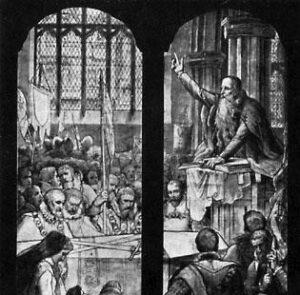An eventful life
John Knox studied at the University of Glasgow. He may have been a priest but his occupations were as a notary and a tutor. He was converted to the Reformation in 1546 and became a pastor at Saint-Andrews. He was taken prisoner by the French at Saint-Andrews in 1547, and made a galley slave.
He was freed in 1549 and went to England and was appointed chaplain to young King Edward VI.
When Mary Tudor became queen in 1553, he fled to France and then to Geneva where he met Calvin. As a pastor of the English Church, he worked on the translation of the Geneva Bible into English. He developed a liturgy in English, heavily influenced by the Geneva liturgy. It later was adopted as the liturgy of the Scottish Church.
In 1555, he went back to Scotland to preach the calvinist Reformation, but had to flee away again to come back for good in 1559.
The reformer of Scotland
The Reformation was established in Scotland for political and religious reasons. The monarchy was weak as Mary Stuart still was under age. Marie de Guise was the regent until 1560. Two parties were opposed, namely the French one favourable to Catholicism, and the English one favourable to Protestantism.
In 1560 the noble protestants’ revolution consisted in abolishing papacy, idolatry, and mass. Marie Stuart came back to Scotland in 1561 after her husband, the king of France François II, had died. But she could not establish her authority and France, in the midst of the Wars of Religion, could not back her. John Knox through his sermons contributed to her deposition in 1567, and then had a lot of influence on the new king James VI. John Knox was one of the founders of the Presbyterian Church in Scotland, his main contribution being the liturgy : The Book of Common Order.
His works
In The First Blast of the Trumpet against a Monstrous Regiment of Women published in Geneva in 1558, the targets were women in power, namely Marie de Guise, Mary Stuart, and Mary Tudor who defended Catholicism. John Knox was the first in Scotland to elaborate the notion of resistance to the tyrant.
He also wrote The History of Reformation in Scotland, published in London in 1587.









